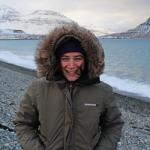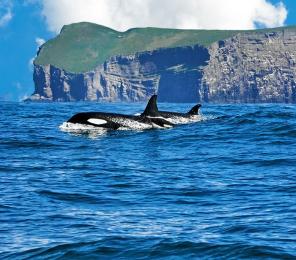
Filipa Samarra, Ph.D.
Dr. Filipa Samarra (She, Her, Hers) is the Lead Investigator of the Icelandic Orca Project. Filipa has spent years studying killer whales and is excited to harness the power of citizen science to collect large quantities of data that will help to better understand and ultimately protect this important apex predator.
What is the most interesting aspect of working with killer whales?
As a species, killer whales show a remarkable variety of feeding behaviors, adapted to each specific habitat and prey, and have intricate social relationships and communication systems. Because they are top predators, they play a key role in ecosystems – they can change prey populations and those effects can propagate all the way down the food chain and reshape ecosystems. All of these aspects of their lives are interconnected so to understand each population you have to look at the big picture. You have to go beyond individuals and their behavior and also study their relationships, how they interact with each other and their ecosystem as a whole, adopting a multi-disciplinary and collaborative approach.
What inspired you to begin researching this species?
Although I grew up in the city, since I was about five years old watching wildlife programs on TV, I was captivated with nature and wanted to be a marine mammal biologist. Working with killer whales started by chance, when I was studying for my Master’s degree. I had the opportunity to work on acoustic communication of killer whales and from the moment I put the headphones on and heard their chatter I was hooked. The variety, complexity and sheer beauty of their sounds was enchanting. I had to find out more about their lives.
How does citizen science support your research?
Citizen science is crucial to our research. For example, we often rely on pictures sent to us through social media by people on board boats in remote or distant locations to find out where orcas go and who goes where. Without these contributions we would be limited to the places where we can work and our knowledge of this highly mobile species would be severely impacted. This simple gesture of sharing a photo can bring such a wealth of information and it shows how science is open to everybody and how science needs everybody to get involved. When citizen scientists join us they can experience first-hand how their contribution is helping us better understand this killer whale population. Hopefully these experiences inspire them to take their acquired skills to continue participating in research.
What is your favorite moment in the field?
I am lucky to study one of the most amazing marine top predators that live in a breathtaking landscape, so life in the field is full of beautiful moments. But one great moment happened at the start of one of our summer field seasons in Iceland when we photographed an unfamiliar adult male orca. We can recognize individual whales by markings in their fins and coloration patterns, but this one didn’t look familiar despite being quite well marked. When we got home later that day and dug through the catalogue of known whales we realized he was there but hadn’t been seen in 20 years! In other places where local orca populations are well known, when an individual disappears for 1 or 2 years it is presumed dead. It just made me realize how little we know about this population and how crucial long-term monitoring is to understanding it.
Education
- Ph.D. in Biology, University of St Andrews (U.K.)
- M.Res. in Environmental Biology, University of St Andrews (U.K.)
- B.S. in Biology, University of the Azores (PT)
